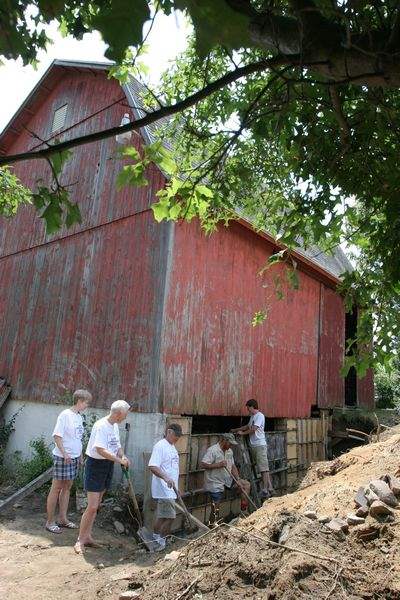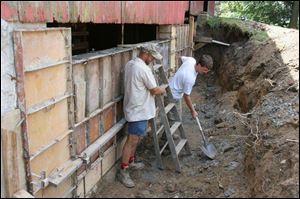
Delta: Old barn could be rescued from ruin
7/27/2005
Great-grandchildren of John Luke, who purchased the land in 1877, from left, are Sally Deese, Patricia Beam, and John Neorr; Larry Miller of Archbold and Jeremy Fry help with the work.
long / blade

Great-grandchildren of John Luke, who purchased the land in 1877, from left, are Sally Deese, Patricia Beam, and John Neorr; Larry Miller of Archbold and Jeremy Fry help with the work.
An old barn near Delta is part of a growing trend.
With its cobwebbed corners and dusty beams, the barn hasn't been used for years, but it could serve as the foundation of a working farm project in the coming years.
Mark Ballmer of Fayette, who was hired to rescue the barn from ruin, said that across the country, efforts are under way to preserve historic barns and find new uses for the structures.
The old barn near Delta stands on land purchased by John Luke in 1877. Last week three of his great-grandchildren gathered here to cultivate plans and sow seeds for the old barn's future. John Neorr, of Seattle, Wash., Sally Deese, of Upper Marlboro, Md., and Patricia Beam, of Pittsburgh, Pa., spent several days at the farm in Fulton Township where their mother, Marie Neorr, lives.
Although the Neorr children have lived out of state for many years, they still call the farm home, and said that they want their children and grandchildren to experience the peace, serenity, and special feeling that the land here offers.

Miller and Fry dig around the barn.
Located along a little-used gravel road, the farm is a haven for deer, pheasants, raccoons, birds, and other wildlife. Hickory, black walnut, chestnut, butternut, and buckeye trees dot the landscape. A fishing pond beckons. "In the fall, all that you hear is the wind rustling and the birds singing," said Mr. Neorr. "It's priceless."
As the family develops plans to preserve the 130-acre farm forever and ever, "the challenge will be to save and maintain the peace and quiet," he said. "We don't want 10,000 people here with kids running around with whirligigs. We want to preserve the integrity of the farm. That's the challenge."
If possible, the Neorr children would like the farm to look like the past, circa 1950s and 1960s. Mr. Neorr notes that farm life for other periods, such as the 1800s, has been preserved through places such as Sauder Village near Archbold, but "people are not thinking about preserving the 1950s and 1960s. That's not an era being preserved."
Young people today, he said, lack opportunities to experience farm life that involved milking parlors and threshing machines; chicken coops and farrowing houses; sheep shearing and corn husking.
"If we had a working farm, kids could come out and see the lambs and see what farm life was all about back then," said Mr. Neorr.
Repairing the barn is the critical first step in recapturing the lofty past.
It will be up to the Neorr family to find a "market so they can show off what their ancestors did here with the land and their hands," Mr. Ballmer said, such as a farm that features organic foods for sale to the public or a bed-and-breakfast where guests could pitch in with daily chores.
Research shows that old barns are still valuable today and the uses are unlimited, such as for dairy operations, hog farrowing operations, and for different aspects of agriculture, such as machine workshops, woodworking shops, and seed storage, said John Olson, program coordinator for the Barn Again! program at the National Trust for Historic Preservation.
People are starting to realize that barns are vanishing from the landscape, and that there are only so many times that barns can be torn down before the buildings become just memories, Mr. Olson said. "People are starting to realize that barns are escaping from us and they are trying to save the ones that are left."
Because the farm economy doesn't allow old barns to be preserved as museum pieces, families are finding ways to make them usable again, he said.
Restoration work on the Neorr's three-bay bank barn will cost up to $25,000 to make it usable again, but Mr. Neorr said that "this is our legacy. This is the important, significant first event. We hope this inaugural event will lead to something worthwhile."